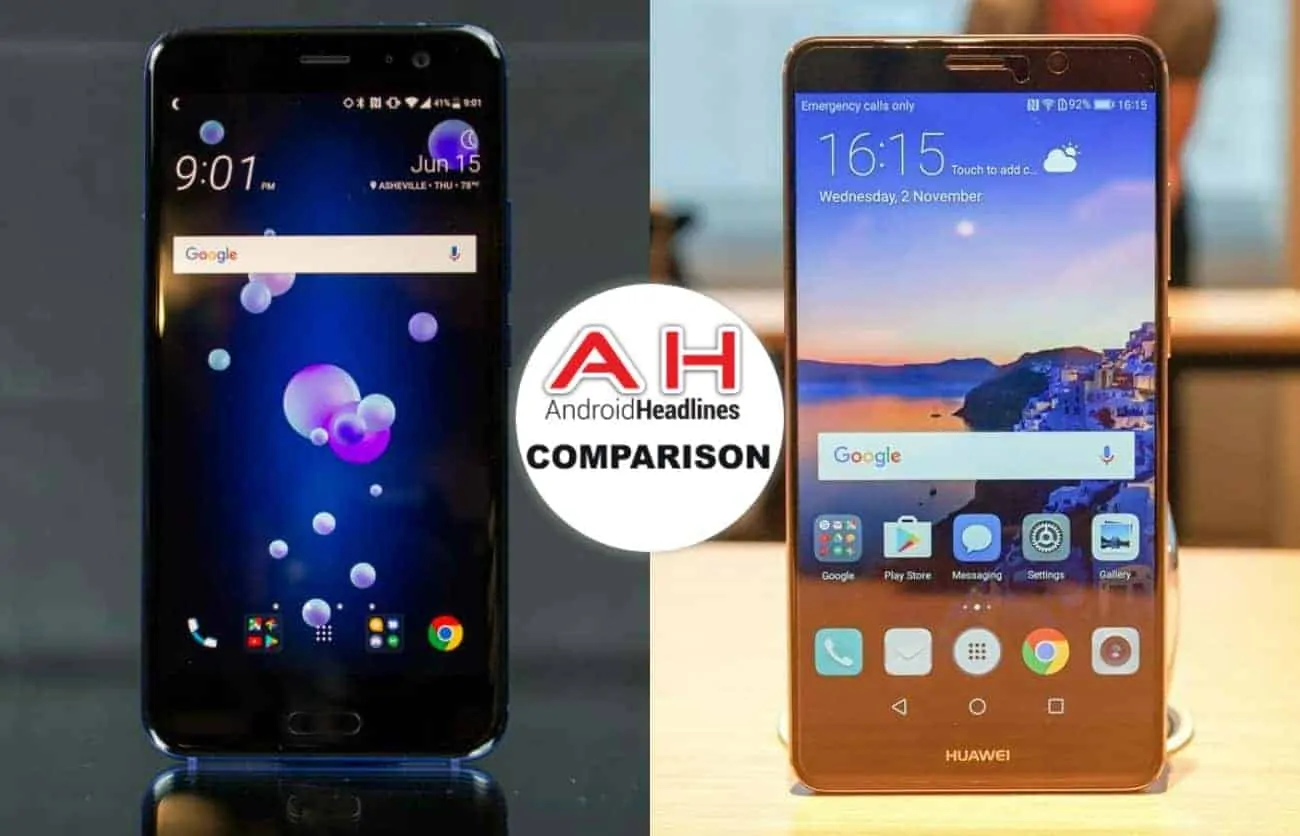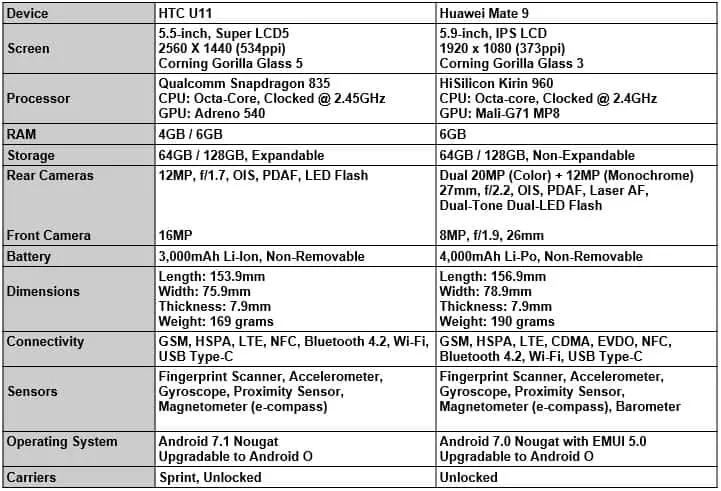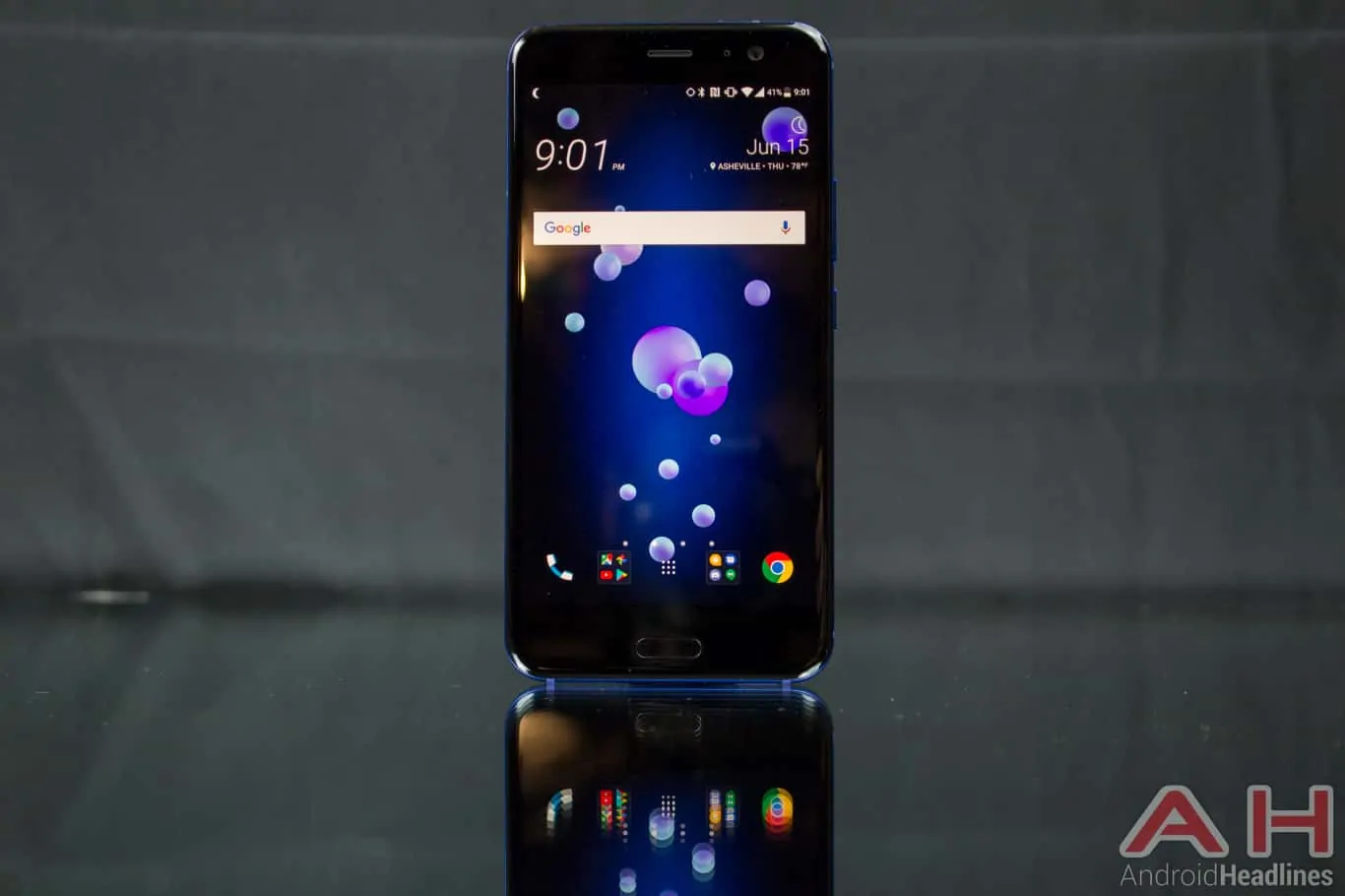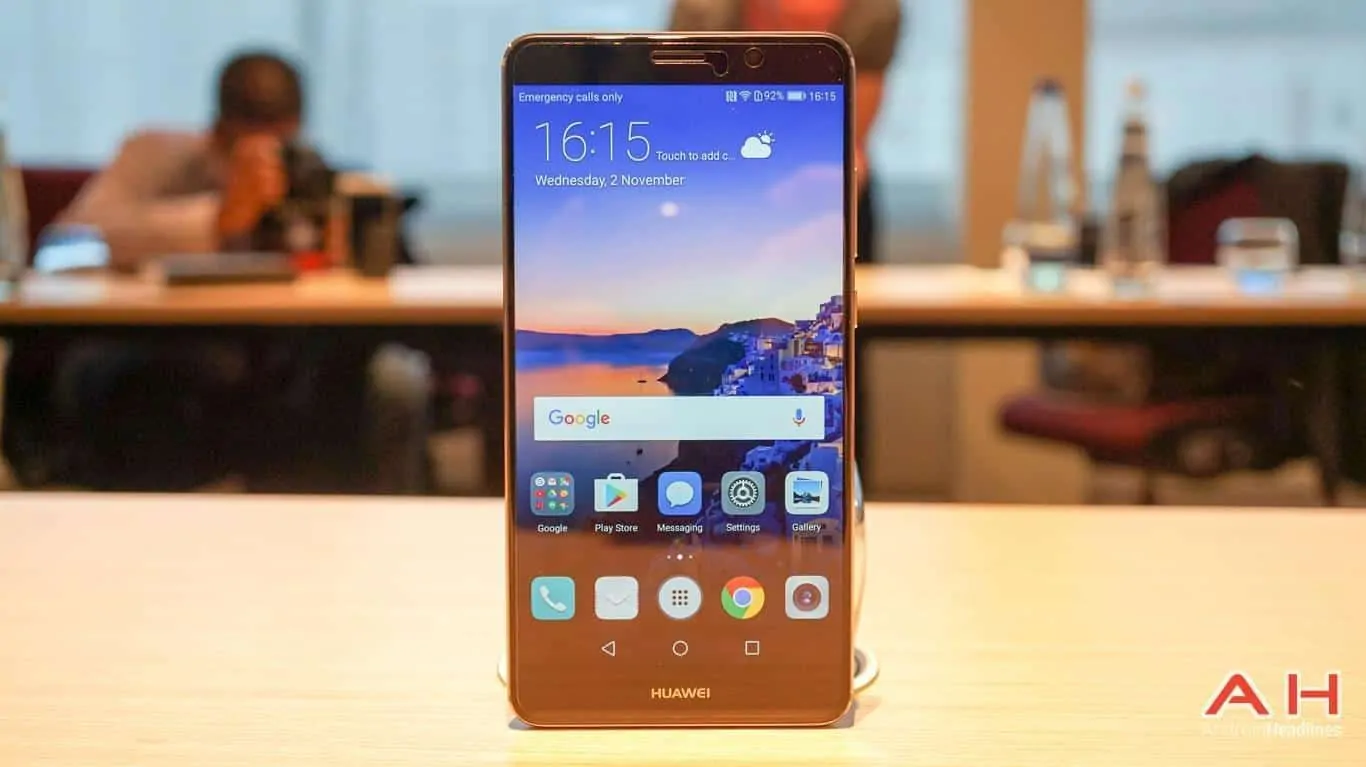Introduction
The HTC U11 and the Huawei Mate 9 are two high-quality smartphones that go up against one another in today’s comparison. The former was launched earlier this year by the Taiwanese vendor that was once one of the preeminent names in the smartphone industry, credited with popularizing the Android platform with revolutionary devices like the Hero and the Evo. Of late, however, the company has been experiencing serious financial trouble with its smartphones often failing to hit the right note with their target audience. That being the case, the company has been banking heavily on the U11 to change its fortunes and towards that end, is offering some really interesting features in the device, both in terms of its hardware and software. The Mate 9, on the other hand, comes from the Chinese telecom giant that has experienced a dramatic rise in fortunes over the past couple of years and, has risen to the top echelons of the global smartphone industry on the sheer strength of its market-share in China, where it has been the number one smartphone brand for some time now. Both devices ship with premium hardware and, come with not-too-dissimilar price-tags, so let’s pit them against one another and see which one is deserves your money and why.
Specifications
HTC U 11
The HTC U11 is said to be the world’s first ‘squeezable’ smartphone, thanks to a unique feature called ‘Edge Sense’ that allows users to squeeze the sides of the device to interact with the phone in various different ways. The feature supports both long and short squeezes, and by default, launches Google Assistant with a long squeeze and fires up the camera with a short one. The best part about the whole deal is that Edge Sense is customizable, which allows users to change what the squeezing does, enabling them to assign any other app to their squeezes according to their choice. The device also comes with a glossy ‘Liquid Surface’ design that follows the design language of earlier HTC launches like the U Ultra and U Play that saw the company switch from a metallic exterior to glass panels on the back. It is also the very first mainstream smartphone to officially support not one, not two, but three AI-based virtual digital assistants, namely, Google Assistant, Amazon Alexa and the company’s very own HTC Sense Companion.
In terms of its specs, the HTC U11 features a 5.5-inch WQHD (2560 x 1440) Super LCD5 capacitive touchscreen display that’s protected by Corning’s Gorilla Glass 5. It is powered by the Qualcomm Snapdragon 835 SoC which comes with an integrated CPU with eight custom Kryo 280 cores, four of which are clocked at 2.45GHz while four others run at 2.19GHz. An integrated Adreno 540 GPU takes care of all the graphics processing needs. The HTC U11 ships with 4GB of RAM and 64GB of built-in storage in the U.S. with support for microSD cards of up to 256GB in capacity. It also comes with a USB Type-C port for charging and data syncing, but misses out on the 3.5mm audio port. The handset ships with a 3,000 mAh Li-ion battery with support for Quick Charge 3.0, while sensors include a front-mounted fingerprint scanner integrated into the physical Home button, alongside an accelerometer, a gyroscope, a proximity sensor and a magnetometer (e-compass).
In terms of optics, the HTC U11 comes with a 12-megapixel primary camera with the company’s proprietary UltraPixel 3 and UltraSpeed Autofocus technologies. The camera has an f/1.7 aperture, a 1/2.55-inch sensor, phase detection autofocus (PDAF), optical image stabilization (OIS) and a dual tone LED flash. Software features include geo-tagging, touch focus, face detection, HDR and panorama. The camera can record 4K videos at 30fps and 1080p videos at up to 120fps. The front-facing selfie-cam on the HTC U11 is a 16-megapixel unit that can record 1080p videos at 30fps. The HTC U11 measures 153.9mm in length, 75.9mm in width and 7.9mm in thickness, while weighing in at 169 grams. The device also comes with an IP67 certification, which means it is also waterproof and dust-resistant.
Huawei Mate 9
The Huawei Mate 9 is the latest in a long list of Mate-series smartphones that typically ship with large displays. True to tradition, the Mate 9 also features a rather large screen that measures 5.9-inches and, is of the IPS LCD variety with a resolution of 1920 x 1080 pixels. Huawei also likes to use its own, in-house HiSilicon Kirin SoCs to power its smartphones and tablets, and again, there’s no exception to that rule with the Mate 9. The phablet is powered by the Kirin 960 SoC that comes with an integrated octa-core CPU that has four Cortex-A53 cores running at 1.8GHz and four Cortex-A73 cores running at 2.4GHz. The graphics processing duties in the chip is taken care of by ARM’s Mali-G71 MP8 GPU. The Mate 9 packs 4GB of DDR4 RAM and 64GB of internal storage that’s expandable via a microSD card.
Photography is one area where Huawei has really upped its game these days, having tied up with German optics major, Leica, last year. The Huawei P9 series represented the first set of devices from the Chinese telecom major to ship with cameras engineered in association with Leica, and that list has only gotten larger over the past year. The Mate 9 follows the same path, and comes with a dual-camera module from the famed German brand. The dual-camera module incorporates a 20-megapixel RGB sensor for colored photos and a 12-megapixel monochrome sensor that shoots black-and-white photos. The dual-cam setup is accompanied by OIS, PDAF and Laser AF, 2x lossless zoom and a dual tone, dual-LED flash. Software features include touch focus, face detection, HDR and panorama. The front-facing selfie-cam on the Mate 9 comes with an 8-megapixel sensor that accompanied by a 26mm wide-angle lens with an f/1.9 aperture.
Like its predecessor, the Mate 9 also has a rear-facing fingerprint sensor to unlock the device and an NFC chip for compatibility with mobile payment platforms like Android Pay. The handset ships with a 4,000mAh Lithium-Polymer battery with support for the company’s proprietary SuperCharge technology that promises to charge the battery fully in just 90 minutes. On the software side of things, the Mate 9 runs Android 7.0 Nougat out-of-the-box in the form of Huawei’s trademark EMUI (Emotion UI) 5.0. The device measures 156.9mm in length, 78.9mm in width and 7.9mm in thickness, while weighing in at 190 grams.
And The Winner Is …
The Final Word
The HTC U11 and the Huawei Mate 9 are both great devices, so rest assured that whichever one you buy will serve you well over its lifetime. However, for the purpose of this comparison, it was just too hard to ignore all the innovations brought forth by the latest HTC flagship. Sure, you don’t really need three different AI-powered voice assistants in a single device, but it doesn’t hurt to have them either. In fact, it’s often fun to compare the three and see how they stack up against each other. The U11 also comes with the Liquid Sense design language that, admittedly, may not be for everyone, but it does help the device stand out from the sea of me-too smartphones from dozens of manufacturers from around the world. Furthermore, the HTC flagship also packs one of the most desirable SoCs under its hood in the form of the Snapdragon 835, all of which makes it fairly lucrative especially, now that the company has reduced its price by about a $100. As for the Mate 9, it is a fantastic device when taken in isolation, but just can’t compete with what the HTC device brings to the table. Which is why the HTC U11 is the winner in this head-to-head against the Huawei Mate 9 today.
Buy The HTC U11 Buy The Huawei Mate 9





